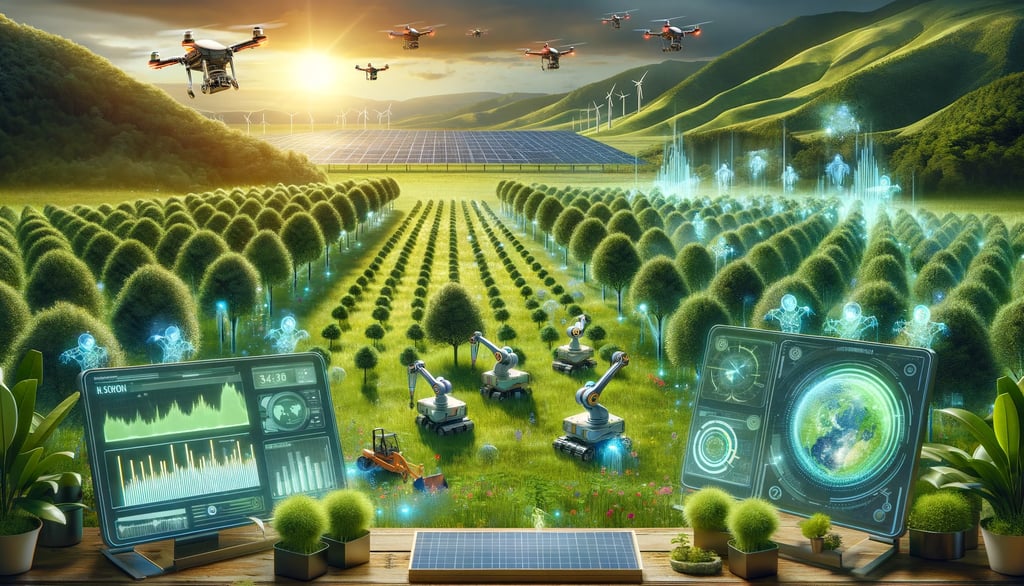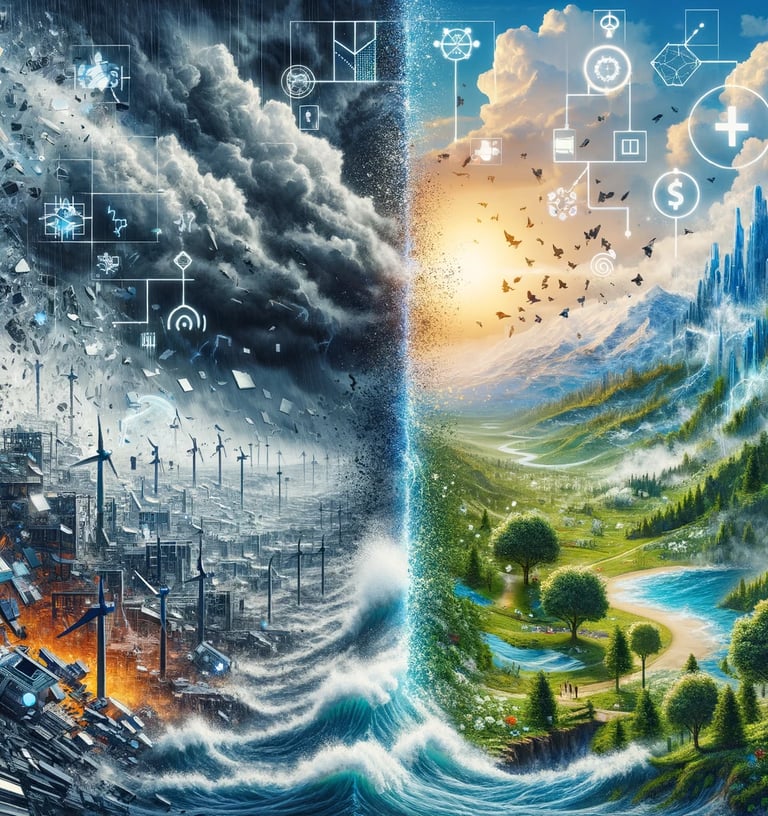AI to the Rescue: Revolutionizing the Fight Against Climate Change
zivaiclimate
2/12/20246 min read


image credit to DALL.E
Introduction
In an era where the clamor for sustainable solutions to the planet's most pressing issue—climate change—is louder than ever, artificial intelligence (AI) emerges as a beacon of hope. The specter of rising temperatures, melting ice caps, and devastating weather patterns looms large over humanity's collective future, compelling a search for innovative and effective strategies to combat environmental degradation. Enter AI, a transformative force poised to redefine our approach to mitigating climate change. This blog post explores how AI technologies offer groundbreaking potential to not only understand and predict environmental phenomena but also to implement practical solutions that reduce emissions, enhance energy efficiency, and foster adaptation to a rapidly changing world. By harnessing the power of AI, we stand on the cusp of revolutionizing our fight against climate change, offering hope for a sustainable and resilient future for our planet.
The Climate Crisis: A Brief Overview
The climate crisis represents one of the most formidable challenges of our time, with scientific consensus underscoring the urgent need for action. Global temperatures are on an unprecedented upward trajectory, with the past decade witnessing the hottest years on record. This relentless warming is attributed to the accumulation of greenhouse gases in the atmosphere, primarily from the burning of fossil fuels, deforestation, and industrial processes. The consequences are far-reaching and catastrophic: polar ice caps are melting at alarming rates, sea levels are rising, threatening coastal communities, and extreme weather events—such as hurricanes, droughts, and wildfires—are becoming more frequent and intense. These changes not only wreak havoc on natural ecosystems, decimating biodiversity and disrupting habitats, but also pose dire threats to human health, food security, and economic stability.
The implications of inaction are stark, painting a future where the planet's ability to sustain life is compromised. Yet, amidst this grim outlook, the potential of AI as a tool for environmental stewardship offers a glimmer of hope. By leveraging AI's capabilities in data analysis, predictive modeling, and autonomous decision-making, we can embark on a more informed and effective journey towards mitigating the impacts of climate change. The following sections delve into the multifaceted role of AI in understanding, combating, and adapting to the climate crisis, highlighting innovative solutions that promise to reshape our environmental future."
AI in Climate Science: Understanding the Earth
The battle against climate change begins with understanding the intricate dynamics of Earth's ecosystems and climate patterns. AI excels in sifting through and analyzing the colossal datasets generated by climate research—data that encompasses everything from temperature trends and ice cap measurements to deforestation rates and oceanic changes. Machine learning algorithms, a subset of AI, are particularly adept at identifying patterns and anomalies within this data, offering predictions about future environmental conditions with unprecedented accuracy.
One of the most significant contributions of AI in climate science is its ability to enhance climate modeling. Traditional models, while invaluable, often struggle with the complexity and interconnectedness of climate variables. AI models, however, can process vast amounts of data in real-time, adjusting for new variables and providing more accurate forecasts of future climate scenarios. This predictive power is crucial for preparing for and mitigating the effects of extreme weather events, such as hurricanes and droughts, potentially saving lives and reducing economic losses.
Furthermore, AI-driven satellite imagery analysis has revolutionized our ability to monitor environmental changes. Algorithms can now detect deforestation, track ice melt in polar regions, and even identify methane leaks from space with remarkable precision. This constant, real-time monitoring provides critical data that can inform policy decisions and conservation strategies, making AI an indispensable tool in the quest to understand and protect our planet.
AI in Emission Reduction Strategies
A cornerstone of combating climate change is reducing greenhouse gas emissions, and AI offers innovative pathways to achieve this goal. In the energy sector, AI algorithms optimize the distribution and consumption of electricity, integrating renewable energy sources into the grid more efficiently. By predicting energy demand patterns and managing supply from wind, solar, and hydroelectric sources, AI minimizes reliance on fossil fuels, reducing overall emissions.
Transportation and manufacturing, two significant contributors to carbon emissions, also benefit from AI interventions. In transportation, AI facilitates the development of smart traffic management systems that reduce congestion and improve fuel efficiency. Autonomous vehicles, guided by AI, promise further reductions in emissions through optimized driving patterns and the potential for integration into shared-vehicle systems. In manufacturing, AI-driven predictive maintenance ensures machinery operates at peak efficiency, while AI optimization of supply chains reduces waste and energy consumption, contributing to lower emissions.
This paradox means that while AI offers solutions for climate change, its development and operation can contribute to the problem unless powered by renewable energy sources.
Moreover, the reliance on AI raises ethical questions related to data privacy, surveillance, and the potential for exacerbating social inequalities. The digital divide between nations means that the benefits of AI may not be equitably distributed, with less developed countries lacking the resources to implement such technologies potentially being left behind. Additionally, the use of AI in monitoring and enforcement activities must balance effectiveness with respect for individual privacy and freedoms.
Ensuring that AI contributes positively to the fight against climate change requires a concerted effort to address these challenges. This involves investing in green computing technologies, establishing robust ethical guidelines for AI use, and fostering international cooperation to ensure equitable access to AI technologies. Only by navigating these complexities can AI fulfill its promise as a transformative tool in the global effort to combat climate change.
The Future of AI and Climate Action
As we stand at the precipice of a new era in the fight against climate change, the role of AI is not just promising; it is pivotal. The future of AI in climate action is brimming with potential, marked by continuous advancements in technology that promise to further enhance our ability to understand, mitigate, and adapt to climate change. Emerging trends in AI, such as improved algorithms for processing complex climate data, autonomous systems for monitoring and protecting biodiversity, and innovative solutions for carbon capture and storage, are set to redefine our approach to environmental stewardship.
One exciting frontier is the development of AI-driven "digital twins" of Earth, enabling scientists to simulate and predict climate outcomes under various scenarios with greater accuracy than ever before. This could revolutionize climate policy, providing a robust basis for decisions on emissions reductions and adaptation strategies.
Moreover, AI's potential to democratize climate action cannot be overstated. Through open-source platforms and collaborative projects, communities around the world can leverage AI tools to tackle local environmental challenges, from urban planning for climate resilience to community-based conservation efforts. The global fight against climate change will increasingly rely on such localized and customized AI solutions, making the technology an indispensable ally in our quest for a sustainable future.
Conclusion
In the monumental task of combating climate change, AI emerges not just as a tool, but as a transformative force capable of reshaping our approach to this global crisis. From enhancing our understanding of Earth's complex climate systems to driving innovations in emission reduction and climate resilience, AI holds the key to unlocking new pathways to sustainability. However, as we harness the power of AI, we must also navigate the ethical and environmental challenges it presents, ensuring that our reliance on technology advances the cause of climate justice and equity.
The journey ahead is fraught with challenges, but the integration of AI into climate action offers a beacon of hope. By embracing the potential of AI, we can forge a future where technology and human ingenuity converge to protect our planet for generations to come. The fight against climate change is a collective endeavor, and AI stands as a testament to what we can achieve when we unite in the face of adversity.
References
Rolnick, D., et al. (2019). "Tackling Climate Change with Machine Learning." arXiv preprint arXiv:1906.05433.
Vincent, J., and B. S. Frey. (2018). "How AI Can Be a Force for Good in the Fight Against Climate Change." The Guardian.
Soden, B. J., et al. (2021). "AI and Climate Modeling: Challenges and Opportunities." Nature Climate Change, 11, 701-708.
Global Partnership on Artificial Intelligence (GPAI). (2020). "Responsible AI for Climate Action." GPAI Reports.
Microsoft. (2020). "AI for Earth: Innovation for the Planet." Microsoft AI.
United Nations Framework Convention on Climate Change (UNFCCC). (2019). "Climate Action and Support Trends." UNFCCC Report.


Challenges and Ethical Considerations
Despite its potential, the application of AI in combating climate change is not without its challenges and ethical considerations. One of the primary concerns is the environmental impact of training AI models themselves, which requires substantial computational power and, by extension, energy.
